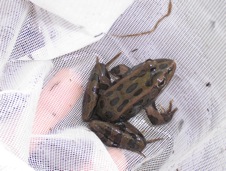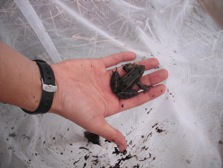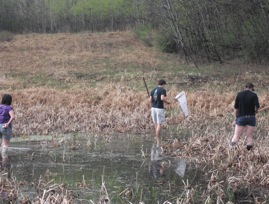Leopard Frog page 2
Contact
Katharine Ordway Natural History Study Area9550 Inver Grove Trail Inver Grove Heights, MN 55076 651-455-6204 (On Site)
651-696-6230 (On Campus)
andersonm@macalester.edu
Biotic Inventory: Documenting Diversity at the Katharine Ordway Natural History Study Area
Rana pipiens, The Northern Leopard Frog


Taxonomy
Kingdom Animalia
Phylum Chordata
Class Lissamphibia
Order Anura
Family Ranidae
Genus Rana
Species pipiens
Common names: the Northern Leopard Frog, the grass frog, the meadow frog
Diagnostic Characteristics
Identifying a Northern Leopard frog can prove to be difficult for many inexperienced frog enthusiasts mainly because these frogs are very similar in size, color and morphology to many other frogs. The leopard frogs grow to 3 ½ inches long and produce a low, snoring or rumbling croak mixed with grunts and squeaks, different from many loud croaks of familiar frogs because the leopard frogs do not possess an air sac 5. Generally, their advertising call is a hoarse croaking followed by two clucks, and their aggressive calls consist of short chuckles. Leopard frogs make four different kinds of calls. Their vocalizations can represent advertisement, aggression, courtship rituals, or defense1. Calls vary among individuals, however, and are hard to interpret. Along with which, these frogs have three morphological types, the common type, the Kandiyohi and the Burnsi type 1.
The most common type which is found in adulthood with black spots scattered randomly about the back and on the sides with a plain white underside. There are two light (though sometimes a shade of gold) dorsolateral ridges down the back with spots on the forelimbs and “tiger stripes” or bars on the hind legs. The groin and thighs have a greenish and sometimes yellowish tint to them. The brown specimens, pictured above in pictures 1 and 2, differ from the closely related pickerel frogs by having round spots scattered about the back and a greenish wash on the thighs. The Kandiyohi form is relatively rare in Minnesota and has not been catalogued in Ordway, but has been catalogued elsewhere in Minnesota 2. These are brown with distinct dashes of white and brown or black. The spots on the back and legs are still discernable, as well as the dorsolateral fold. Lastly, the Burnsi forms have been documented in Ordway, although they are relatively rare and a picture was not able to be taken. It is brown with no dorsal spots, yet has spots or bars along the limbs, and may have black stippling on the back and sides 2. In most of the Burnsi types found in Minnesota, they are known to remain light and have a yellowish tint to them.
The hydrophobic skin covering the frogs is moist and smooth, making them elusive for predators and quick underwater. Their skin contains mucus that they secrete in order to keep the skin from drying out and also these secretions are sometimes found to be poisonous1. Although not harmful to humans, these secretions are powerful enough to deter their predators in the marshes and wetlands.
Ecology
As seen in picture 3 above, these leopard frogs are found in permanent ponds, swamps, marshes and slow moving streams throughout forest, open and even urban areas. They are normally found in ponds with abundant aquatic vegetation, upon which they tend to hide. These frogs are well adapted for living in a cold environment and can be found well above 3,000 meters. During the harsh Minnesotan winters, these frogs move to the bottoms of lakes and ponds, where it is naturally warmer 3.
The tadpole’s and froglet’s diet differs from those of the adult because they feed primarily on algae and microscopic organisms1. The adult frogs, however, are fierce predators, feeding on the excess of insects and mosquitoes present in the Minnesotan and tundra climate. Not only do they feed on the insects such as crickets, flies and mosquitoes, but they also feed on slugs, snails, worms and smaller vertebrates such as the chorus frogs that they live beside and often will hear with their calls3.
Save from being fierce predators in their ecosystem, they are also fiercely preyed upon. Herons, snakes and mammals (including humans), and even other frogs prey on the leopard frog.
Life History
Copulation occurs in the water mainly between the months of March into late June. The females release eggs while swimming and the male attaches himself to the female with specialized thumbs, allowing him to fertilize the eggs. The females are known to lay more than 6,000 eggs at a time which may vary from submerged egg masses in northern populations to a surface film of eggs in southern populations2. The black eggs are attached to aquatic vegetation and hatch within 13-20 days and transform in 70-120 days2.
The life cycle of the leopard frog is fairly simple and is very similar to that of many other frogs. When the eggs first hatch they are tadpoles which lack any kind of limbs or lungs. The tadpole then undergoes metamorphosis, growing hind legs initially, then the front legs and the head simultaneously. The gills are later replaced with lungs and the froglet begins to slowly adapt to life on land. On land, the frog then loses the tail and continues to grow in size until fully developed. The leopard frog grows until it reaches sexual maturity in 2 to 3 years, mating and beginning the cycle once again 1, 2.
Distribution
The Northern Leopard frog is endemic to the northern United States and into much of Canada. These frogs have even been reported to live in climates such as the mountains of New Mexico and north into Alaska 4. The leopard frog’s range varies so intensely because of its migratory habitats and abilities to go lengths of time without water. The range of the northern leopard frog in southern New England overlaps somewhat with that of the southern leopard frog, a sibling species that can be deceptively similar in appearance. Their migratory habits are, however, limited between aquatic breeding and wintering habitats and nearby summer feeding areas. Summer movements of adult frogs include mostly short distance (e.g. a few meters to 45 meters) nocturnal travel. More extensive summer movements have also been documented, upon which they are known to have traveled miles in one night 4.
Threats and Conservation Issues
Recently, malformed frogs have become a serious issue. Amphibian malformations have been recorded in 44 states and in nearly 60 species. These malformations are found throughout the United States and Canada, but first became a real problem in Minnesota. An abnormally high number of mutations occurs in the leopard frogs, and between 1995 and 2000 this stemmed a vast study to determine the causes. Missing or extra limbs, digits and eyes, partial limbs and malformed jaws, among other problems, threatened the livelihood of many frogs, threatening the population to dangerous levels 5. Nearly all the malformed frogs found are juveniles, indicating that they rarely survive to adulthood. Scientists do not know the exact causes of these malformations, but they have started to present several theories. Malformations at several sites in Minnesota have been linked to the presence of a parasite Ribeiroia ondatrae, a flatworm that burrows into tadpoles5. Frogs infected with this parasite at these sites develop severe deformities. Another cause linked to northern leopard frog malformations is pesticides. However, tests done at the research sites in Minnesota did not find high quantities of pesticides in the water.
Researchers also believe that man-made chemicals other than pesticides may have an adverse affect on frogs as well. However, some studies show conflicting results. Some chemicals that are thought to be linked to malformations, such as methoprene, have been found not to affect the malformation of R. pipiens at levels commonly found in the environment5.
Another hypothesis is that the increasing amount of ultraviolet light hitting the earth’s surface may cause some malformations5. Most researchers believe a combination of all of these factors, human and naturally caused, that result in the deformities found in so much of Minnesota.
Voucher Information
This specimen pictured on the first page was found in a permanent, fish-less pond with ample vegetation at the Katherine Ordway Natural History Study Area in Inver Grove Heights, Minnesota. Along with these frogs, there were an abundance of other frogs, such as small chorus frogs, living beside them. Also, these frogs had just begun to breed, for these were caught in mid May during an unusually warm year.

References
1. Minnesota Department of Natural Resources: http://www.dnr.state.mn.us/reptiles_amphibians/frogs_toads/truefrogs/northernleopard.html
2. Reptiles and Amphibians of Minnesota: http://www.herpnet.net/Minnesota-Herpetology/frogs_toads/NorthernLeopard_frog.html
3. USDA Forest Service: http://www.fs.fed.us/r5/snfpa/final-seis/vol1/chapter-3/3-2/3-2-2/32210.html
4. National Geographic: http://animals.nationalgeographic.com/animals/amphibians/northern-leopard-frog/
5. US Fish and Wildlife Service: http://www.fws.gov/nevada/nv_species/nleopard_frog.html
Compiled by Kai Cowger.
Biodiversity & Evolution (BIOL 270) Professr Sarah Boyer. Spring 2010
Specimen collected at Macalester College’s Katharine Ordway Natural History Study Area on April 15, 2010.